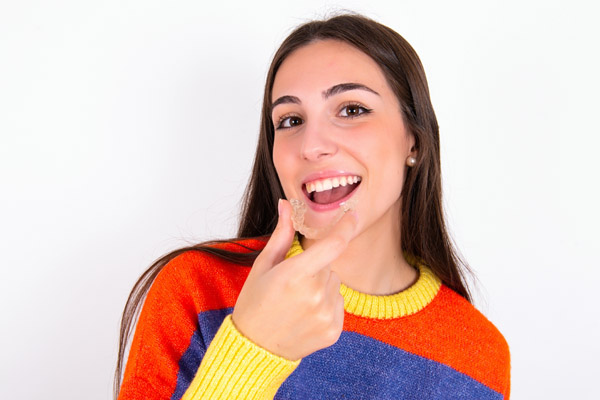How an Orthodontist Uses Elastics for Treatment

Often, the primary focus of treatment from an orthodontist is addressing misaligned teeth. However, jaw misalignments can also cause cosmetic and oral health concerns. To help ensure the adequate correction of jaw alignment, as well as the teeth, orthodontists may use elastics.
How an orthodontist uses elastics during orthodontic treatment
Orthodontists use elastics to treat bite complications such as crossbites, overbites, and underbites. Elastics are used at the same time as braces (or sometimes clear aligners) to allow for quicker results for patients. This review discusses the role of elastics in treating jaw and teeth misalignment through orthodontic care.
What are elastics in orthodontic treatment?
Elastics in orthodontic treatment, also sometimes called inter-arch rubber bands, are stretchable loops that are strategically positioned to keep the upper and lower jaw in the proper position. They are used to correct various bite complications that are common among orthodontic patients. The elastics are generally made of latex material. Elastics are most commonly used with traditional braces, although some clear aligner treatments utilize a variation of elastics to achieve a similar purpose.
When would an orthodontist use elastics?
Orthodontists use elastics to correct bite misalignments for their patients. Treatments such as traditional braces pull teeth into better alignment. However, this is not always enough to correct the jaw misalignment, in which case, elastics are used. Examples of bite complications that an orthodontist may address with elastics include:
- Overbite
- Underbite
- Crossbite
- Open bite
An orthodontist can assess the severity of the misalignment during the consultation or early on in the treatment process and determine what role elastics should play, if any, in the treatment plan.
The importance of wearing elastics if recommended
Not all orthodontic patients are required to wear elastics, although many (if not most) patients will have to at some point during their treatment. Elastics can feel slightly uncomfortable and awkward at first. It is important to not stop wearing the elastics after the initial discomfort, as the jaw misalignment may not improve from the braces or clear aligners treatment alone.
The long-term benefits of wearing elastics
The purpose of elastics is to correct jaw misalignments. In doing so, the patient can improve the appearance of their smile with a more symmetric and even bite. While many are familiar with the cosmetic benefits, fewer are aware of how elastics can improve oral health. People with bite complications are at an increased risk of bruxism, which could damage teeth and increase the risk of temporomandibular joint disorder. Elastics correct the bite, reducing these risks, in addition to creating a more attractive jaw alignment.
Common questions about orthodontic elastics
Here are the answers to some common questions about elastics during orthodontic treatment to help you determine if they are right for you and ensure they are worn properly if they are recommended.
How long does it take for elastics to correct a bite?
This depends on how well the patient follows the orthodontic plan. In most cases, patients are asked to wear their elastics for 24 hours a day, only removing them when it is absolutely necessary. When worn properly, the patient should see and feel noticeable results in approximately seven months, although results may vary widely depending on the severity of the malocclusion and the patient’s age.
What are the dos and don'ts of wearing elastics?
Of course, the most notable instruction for elastics is to wear them as much as possible. Otherwise, the jaw has a tendency to remain in its current alignment. Patients are usually advised to remove them while brushing and eating, but the elastics should be replaced right afterward. It is not recommended to ever double up on your elastics even if you miss a day of wearing them; this is actually counterproductive and may slow the success of treatment.
Do I have to wear elastics while I eat?
Elastics are most effective when they are worn 24/7. This means it is recommended that you wear them while you are eating. However, in cases where eating becomes too challenging because of the elastics, they may be removed. It is important to replace them once you are finished eating.
The bottom line
Here at our orthodontic practice, we do all that we can to ensure that all our patients have a positive experience. If you are not happy with the alignment of your teeth and jaw or are searching for an experienced orthodontist for your child, contact our practice today to schedule a consultation.
Request an appointment here: https://www.orthodonticprecision.com or call Precision Orthodontics & Pediatric Dentistry at (703) 391-8800 for an appointment in our Reston office.
Check out what others are saying about our dental services on Yelp: Orthodontist in Reston, VA.
Recent Posts
There are various options for straightening teeth. Invisalign® for teens is a popular option for this age group, as it is less obvious than traditional metal braces. Invisalign consists of clear trays that fit over the top and bottom rows of teeth. This straightening method has many benefits. However, not everyone is a good candidate.…
It is easy to understand why Invisalign® for teens is such a popular teeth-straightening treatment. It removes the need for traditional braces that can be cumbersome, conspicuous, and sometimes painful. Parents and teens alike should find out all they can about Invisalign® treatment before making the decision to proceed.If you are not sure what to…
If your teen needs teeth straightening, Invisalign® Teen is one potential option you can choose. The treatment has both benefits and drawbacks when compared to traditional braces.Invisalign is a brand of clear aligners that can be used in place of traditional braces for straightening teeth. The Invisalign Teen treatment differs only slightly from the adult…
As a child’s mouth and teeth develop into adolescence, it may become apparent that there are problems with alignment or spacing. Invisalign® for teens presents an alternative to traditional metal braces but without sacrificing the quality of results of corrective treatment. The specifics of a teen’s condition may impact the eligibility of this alignment option,…


